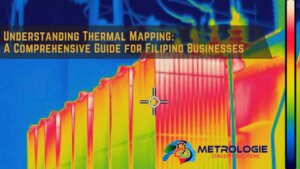Thermal mapping, also known as thermography, is a powerful non-destructive technique that harnesses infrared radiation to visualize and quantify temperature variations across surfaces. This technology has become indispensable across a multitude of industries, from building inspections and electrical maintenance to medical diagnostics and industrial process control. However, the accuracy and reliability of thermal mapping data depend heavily on a deep understanding of the underlying scientific principles and the key metrics involved. This comprehensive guide unravels the science of thermal mapping, meticulously examining the crucial metrics and their significance in generating meaningful and actionable insights.
Unveiling the Physics of Thermal Mapping:
At its core, thermal mapping relies on the fundamental principle that all objects with a temperature above absolute zero emit infrared radiation. This radiation, a form of electromagnetic energy, is invisible to the human eye but can be detected and measured by specialized infrared cameras. These cameras translate the emitted infrared radiation into a visual representation of temperature distribution, known as a thermogram or thermal image.
Key Metrics in Thermal Mapping and Their Significance:
- Emissivity (ε): The Surface’s Radiative Signature:
- Definition: Emissivity quantifies a surface’s efficiency in emitting infrared radiation compared to a perfect blackbody (an idealized object that absorbs and emits all radiation).
- Importance: Emissivity is a critical factor in accurate temperature measurements. Different materials exhibit varying emissivities, and neglecting this can lead to substantial errors in temperature readings.
- Factors Influencing Emissivity: Material composition, surface texture, oxidation, and viewing angle.
- Practical Applications: In building inspections, understanding the emissivity of building materials is vital for accurately assessing insulation effectiveness. In electrical inspections, emissivity correction helps pinpoint genuine hot spots in components, distinguishing them from reflective surfaces.
- Temperature Resolution (NETD): Detecting Subtle Thermal Differences:
- Definition: Noise Equivalent Temperature Difference (NETD) represents the smallest temperature difference that a thermal imaging camera can discern.
- Importance: A lower NETD signifies higher thermal sensitivity, enabling the detection of minute temperature variations. This is crucial for applications where subtle thermal changes are indicative of underlying issues.
- Measurement Unit: Millikelvins (mK).
- Practical Applications: In medical diagnostics, a high-resolution camera with a low NETD can detect subtle temperature variations associated with inflammation or circulatory problems. In predictive maintenance, it helps identify incipient failures in machinery by detecting subtle heat patterns.
- Thermal Sensitivity: Responsiveness to Temperature Changes:
- Definition: Thermal sensitivity describes the camera’s ability to respond to small temperature fluctuations. It is closely related to NETD.
- Importance: High thermal sensitivity ensures that the camera captures accurate temperature readings even in environments with minimal temperature differences.
- Practical Applications: In building envelope inspections, high thermal sensitivity helps detect subtle air leaks and insulation defects. In industrial process control, it enables precise monitoring of temperature-sensitive processes.
- Spatial Resolution (IFOV): Capturing Fine Details:
- Definition: Instantaneous Field of View (IFOV) defines the smallest area that the camera can measure at a given distance.
- Importance: Higher spatial resolution allows for more detailed and accurate temperature measurements of small objects or intricate features.
- Measurement Unit: Milliradians (mrad).
- Practical Applications: In electrical inspections, high spatial resolution helps pinpoint the precise location of hot spots on small circuit board components. In building inspections, it enables the detection of minute cracks or moisture pockets.
- Temperature Range: Measuring Diverse Thermal Environments:
- Definition: Temperature range represents the span of temperatures that the thermal imaging camera can accurately measure.
- Importance: Selecting a camera with an appropriate temperature range is crucial for the specific application. High-temperature applications require cameras with extended ranges.
- Practical Applications: In furnace inspections, cameras with high-temperature ranges are essential for monitoring refractory lining integrity. In building inspections, a moderate temperature range is sufficient for detecting insulation deficiencies.
- Spectral Range: Targeting Specific Infrared Wavelengths:
- Definition: Spectral range defines the range of infrared wavelengths that the camera’s sensor can detect.
- Importance: Different materials emit infrared radiation at different wavelengths. Selecting a camera with an appropriate spectral range is crucial for specific applications.
- Practical Applications: In gas leak detection, cameras with specific spectral ranges are used to detect the infrared signatures of particular gases. In high-temperature applications, shorter wavelength cameras minimize atmospheric absorption.
- Accuracy and Precision: Ensuring Reliable Measurements:
- Definition: Accuracy refers to the closeness of a measurement to the true value, while precision refers to the repeatability of measurements.
- Importance: High accuracy and precision are essential for reliable thermal mapping data. Proper calibration and measurement techniques are crucial.
- Practical Applications: In medical diagnostics, accurate temperature measurements are vital for diagnosing medical conditions. In industrial process control, precise temperature measurements ensure consistent product quality.
- Frame Rate: Capturing Dynamic Thermal Events:
- Definition: Frame rate represents the number of thermograms captured per second.
- Importance: A higher frame rate allows for capturing dynamic temperature changes and analyzing moving objects.
- Measurement Unit: Hertz (Hz).
- Practical Applications: In mechanical inspections, a high frame rate captures rapid temperature changes associated with rotating machinery. In research and development, it analyzes dynamic thermal processes.
Factors Influencing Thermal Mapping Results:
- Ambient Temperature: The temperature of the surrounding environment can affect the accuracy of thermal measurements.
- Reflected Radiation: Surfaces can reflect infrared radiation from other objects, leading to inaccurate readings.
- Atmospheric Absorption: Water vapor and other gases in the atmosphere can absorb infrared radiation, affecting measurements.
- Distance and Angle: The distance and angle between the camera and the target surface can affect the accuracy of measurements.
Best Practices for Accurate Thermal Mapping:
- Proper Camera Calibration: Regularly calibrate the thermal imaging camera to ensure accuracy.
- Emissivity Correction: Apply emissivity correction based on the material being inspected.
- Ambient Temperature Compensation: Account for ambient temperature when analyzing thermal data.
- Minimize Reflected Radiation: Use reflective shields or adjust the viewing angle.
- Consider Atmospheric Absorption: Account for atmospheric absorption, especially over long distances.
- Use Appropriate Measurement Techniques: Follow established measurement procedures.
- Thorough Documentation: Document all measurement parameters and environmental conditions.
- Certified Thermographers: Employ certified thermographers for accurate data interpretation.
The Future of Thermal Mapping:
Advancements in sensor technology, data analysis, and artificial intelligence are continuously enhancing thermal mapping capabilities:
- Higher Resolution Sensors: Enabling more detailed and accurate thermal imaging.
- Advanced Image Processing: Improving image quality and data analysis.
- AI-Powered Analysis: Automating data interpretation and anomaly detection.
- Hyperspectral Imaging: Expanding the spectral range for detailed material analysis.
- Integration with IoT: Enabling real-time monitoring and predictive maintenance.
Key Takeaways:
- Thermal mapping relies on the principle of infrared radiation emission.
- Key metrics like emissivity, NETD, and spatial resolution are crucial for accurate data.
- Ambient temperature, reflected radiation, and atmospheric absorption can influence results.
- Proper calibration, emissivity correction, and ambient temperature compensation are essential.
- Technological advancements are continuously improving thermal mapping capabilities.
By understanding the science of thermal mapping and applying best practices, professionals can unlock the full potential of this technology and gain valuable insights into the thermal behavior of various objects and systems.


